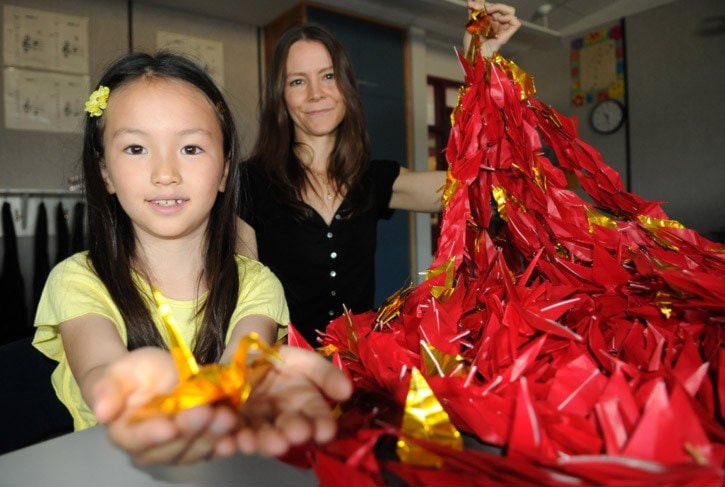The story of a sick Japanese girl attempting to fold one thousand paper cranes before her death was the launching pad for a Chilliwack fundraiser.
Seven-year-old Jaeda Sanada, who lives in Japan, but is staying with her maternal grandparents in Chilliwack, wanted to do something for her friends and family still living in the aftermath of the earthquake that hit the east coast of Japan on March 11.
Upon Jaeda's encouragement – using the story of Sadako Sasaki – three Grade 1 classes at Unsworth elementary folded and sold origami cranes in support of the Canadian Red Cross.
Sadako was a young Japanese girl in the 1950s who had been diagnosed with leukemia, "radiation sickness," after the atomic bomb. As the story goes, she wanted to fold 1,000 paper cranes before her death, but came up short. Her friends and family fulfilled her wish.
In total, the Grade 1 classes at Unsworth elementary folded approximately 380 paper cranes and raised $756 for Japanese relief.
***
On March 11 Leah Sanada was driving her daughter Jaeda home from school in Ichikawa, Japan, just outside Tokyo, when she felt the truck trembling. Stopped at a red light, she thought Jaeda was tapping her feet in the backseat. But when the shaking intensified, and she saw power line posts violently swaying, and a girl on the sidewalk being blown around like a rag doll, she knew her adopted country was experiencing another earthquake.
Like the others, she thought the shaking would stop. It didn't.
An 8.9-magnitude earthquake had struck Japan's east coast – 200 kilometres outside Ichikawa – which spawned a tsunami with waves as high as 124 feet crashing down on the country minutes later.
"It felt like the wheels were coming off the truck, it was unreal," Leah said.
"I didn't know what to do."
While she'd experienced several earthquakes since moving to the country in 1998, she'd usually been at home. The truck was new territory.
"It just kept getting bigger and bigger," she said.
"What if the road opened up in front of me, what was I supposed to do?"
She tried to mask her fear and be brave for her daughter scared in the backseat. With a mother's comfort, she repeatedly told Jaeda everything would be okay.
As the other vehicles moved forward, Leah began to inch her own vehicle forward. When she arrived home, people from the apartment buildings nearby were outside on the grass, neighbours, with their doors flung wide open, protectively held their TVs.
When she opened the door to their house, their toy poodle, skittish, shot outside. Their wall decorations laid shattered on the ground. Their fish tank had just an inch of water left inside, the rest flooding their floors.
"It was scary," said Jaeda, her voice almost muted. "I didn't want to go inside because what if the house falls down."
The shaking continued for days. They didn't know if it was aftershocks or if it was earthquake sickness.
"It was like being on a boat; our heads kept shaking," said Leah.
They feared another massive earthquake. They tied their furniture close to the walls, and had even tied all the doors open, making sure they wouldn't slam shut and trap them in.
Chemical explosions had them holed up inside for days. With the instability of the nuclear plant and predictions of another earthquake and tsunami closer to home, Leah and her husband made the decision for Leah, Jaeda and their dog to seek safety in Chilliwack with Leah's parents.
She thought they'd be here for two weeks. That was more than three months ago.
"They're still shaking quite a lot," said Leah, who talks with her husband and checks status reports regularly.
"It's nothing really big, but it's still very unnerving. We were hoping they would get things under control by now."
With over 25,000 killed or missing, more than 5,000 injured and more than 188,000 people displaced from their homes, this earthquake is Japan's worst disaster in recent history.
The crane represents happiness and long life in Japanese folklore. For everyone who folds a paper crane, a wish is granted.
Jaeda wished her friends had a safe haven just like her.
"We wanted to send good luck to all the people worse off than us," said Leah.
